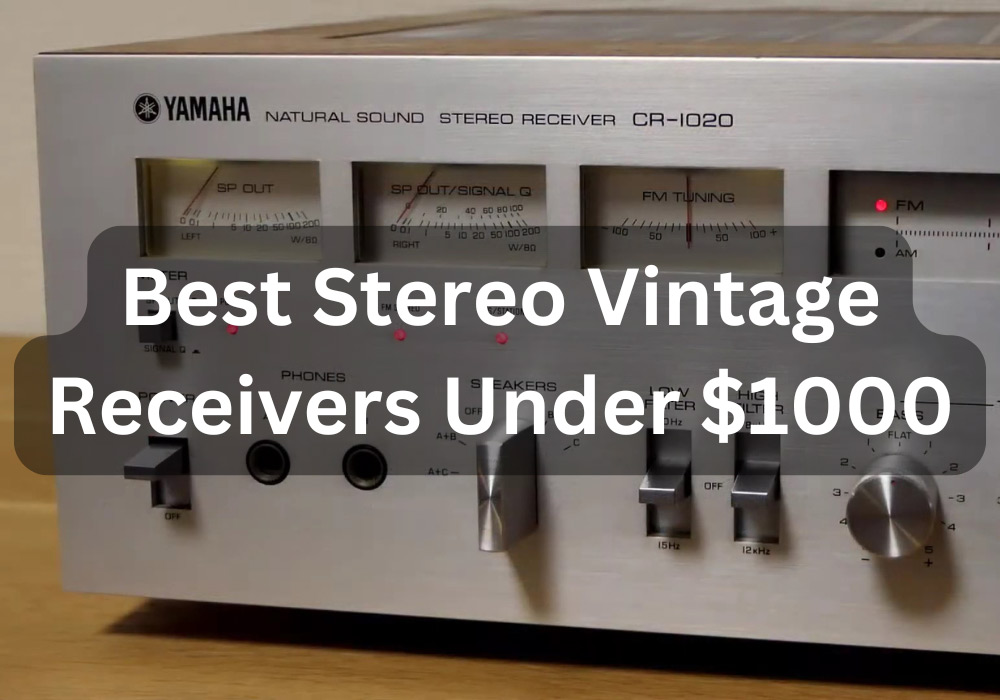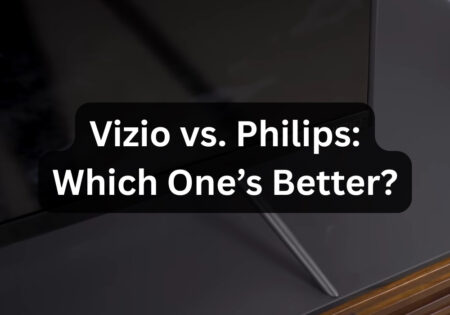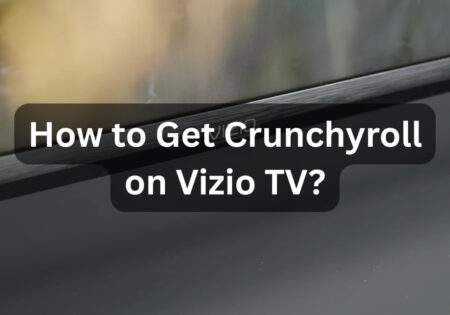If you’re looking for the best vintage stereo receiver under $1000, this is the guide for you. In this new 2024 article, I will introduce and review the best classics from legacy brands like Pioneer, Yamaha, Harman Kardon, Sansui, Marantz, and Concept. You can find the best vintage receiver that suits your Hi-Fi setup exceptionally well.
What Are the Best Vintage Receivers Under $1000? (Quick Answer!)
The best vintage stereo receivers, according to my tests are:
- Pioneer SX-850
- Yamaha CR-1020
- Harman Kardon 730 Twin
- Sansui 7070
- Marantz 2240B
- Concept 11.0
In the table below, you can each model’s specs and compare them at a glance:
| Feature | Marantz 2240B | Sansui 7070 | Harman Kardon 730 | Concept 11.0 | Winner |
|---|---|---|---|---|---|
| Power Output | 40 watts per channel into 8 ohms | 60 watts per channel into 8 ohms | 40 watts per channel into 8 ohms (dual mono) | 110 watts per channel into 8 ohms | Concept 11.0 |
| Phono Inputs | One Phono Input | Two Phono Inputs | Two Phono Inputs | One Phono Input | Sansui 7070 & Harman Kardon 730 |
| Auxiliary Inputs | One Auxiliary Input | One Auxiliary Input | Two Auxiliary Inputs | Two Auxiliary Inputs | Harman Kardon 730 & Concept 11.0 |
| Tape Loops | One Tape Loop | Tape Loops | Two Tape Loops | Tape Loops | Harman Kardon 730 & Concept 11.0 |
| Pre-Out/Main-In Jacks | Yes | No | Yes | Yes | All except Sansui 7070 |
| Speaker Terminals | Supports two sets of speakers (A and B) | Supports two sets of speakers (A and B) | Supports two sets of speakers (A and B) | Supports three sets of speakers (A, B, and C) | Concept 11.0 |
| Build Quality | Solid metal chassis, high-quality components | Solid construction, durable components | Solid internal components, dual power supplies | Heavy-duty chassis, robust power supply | Concept 11.0 |
| Aesthetics | Signature blue backlighting, sleek silver faceplate | Vintage ’70s look, brushed aluminum faceplate | Minimalist design, subtle lighting | Clean design, large illuminated power meters | Marantz 2240B |
| Performance Features | Warm sound, bass/mid/treble controls, loudness switch | Warm sound, tone controls, FM muting, mono switch | Wide frequency response, bass/treble controls, high signal-to-noise ratio | 4-ohm capability, tone controls, loudness switch | Concept 11.0 |
Best Vintage Stereo Receivers Under $1000: Complete Reviews
Moving forward, I’ll review six of the best vintage receivers I think have the highest value for money in 2024. I’ve considered various factors for each model, including build quality, sound signature, features, and aesthetics. Let’s dig in!
1. Pioneer SX-850
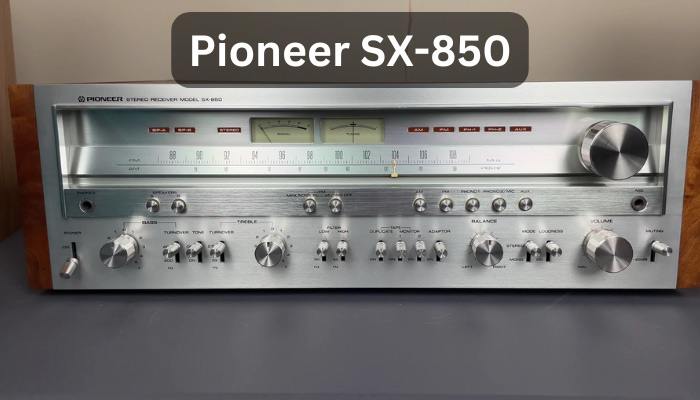
Produced between 1976 and 1978, this vintage stereo receiver is a true blend of performance and aesthetics thanks to its silver faceplate, wooden cabinet, and rich features. The Pioneer SX-850 can deliver 65 watts per channel, making it a stereo receiver capable of handling most home audio setups.
This receiver is known for its balanced sound signature and robust build quality. It doesn’t matter if you’re an audiophile or a casual listener; the SX-850 can satisfy you, and I say it without a doubt.
Key Features
The table below showcases the specs of SX-850:
| Feature | Details |
|---|---|
| Power Output | 65 watts per channel into 8 ohms |
| Phono Inputs | Two Phono Inputs |
| Tape Loops | Two Tape Loops |
| Auxiliary Input | One Auxiliary Input |
| Pre-Out/Main-In Jacks | Yes |
| Speaker Terminals | Supports two sets of speakers (A and B) |
| Build Quality | Real Wood Veneer Cabinet, Solid Metal Chassis |
| Aesthetics | Brushed Aluminum Faceplate, Classic Dial Lighting |
| Performance Features | Excellent Tuner Section, Bass, Midrange, and Treble Controls, Loudness Switch |
Why I Chose the Pioneer SX-850
- Balanced Sound Signature: Audio is clear and balanced, complemented with a slight bass that enhances various music genres.
- Exceptional Build Quality: The components are durable and trustworthy in the long run, along with an overbuilt power supply.
- Timeless Aesthetics: The classic design adds a vintage charm to any room.
- Versatile Connectivity: The device has many inputs and outputs, which means you have many options for connectivity.
- Value for Money: Has high-end features in this price range (below $1000).
Drawbacks of Pioneer SX-850
- Size and Weight: The receiver isn’t the lightest vintage you’d find. It’s large and heavy indeed, requiring ample space and support.
- Dial Lighting Maintenance: The incandescent bulbs probably need to be changed over time.
Also Read:
Best Receiver for Klipsch Speakers
2. Yamaha CR-1020
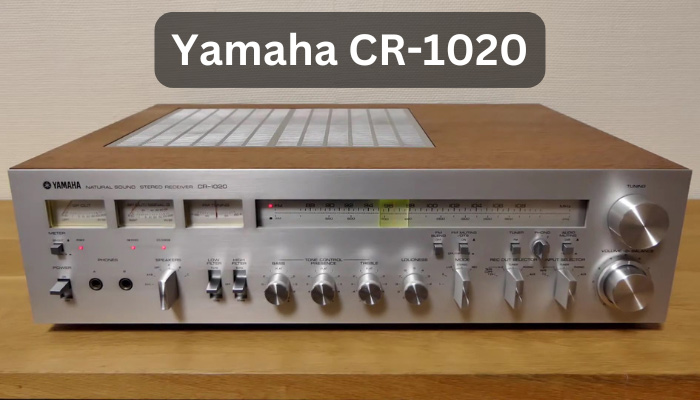
Yamaha CR-1020 is another standout receiver coming from the late 1970s. This receiver, being the model I have in my own home theater system, is a true testament to Yamaha’s dedication to high-fidelity sound and exceptional craftsmanship. It’s got 70 watts per channel power output, making it capable of handling multiple speakers and listening environments.
The CR-1020 effectively reflects Yamaha’s “Natural Sound” philosophy. Just like the previous model, this one too comes with a robust build quality. The real wood veneer cabinet and understated front panel make it an eye-catching device. If you’re somebody who values an uncolored sound, this receiver can definitely blow you away with its level of clarity and neutrality in performance.
Key Features
| Feature | Details |
|---|---|
| Power Output | 70 watts per channel into 8 ohms |
| Phono Inputs | Two Phono Inputs |
| Tape Loops | Two Tape Loops |
| Auxiliary Input | One Auxiliary Input |
| Pre-Out/Main-In Jacks | Yes |
| Speaker Terminals | Supports three sets of speakers (A, B, and C) |
| Build Quality | Real Wood Veneer Cabinet, Solid Metal Construction |
| Aesthetics | Minimalist Design, Variable Loudness Control |
| Performance Features | Excellent Tuner Section, Bass, Midrange, and Treble Controls, Variable Loudness Control |
The CR-1020 epitomizes Yamaha’s “Natural Sound” ethos, with a solid build and sleek design, offering striking clarity and pristine, uncolored sound.
Why I Chose Yamaha CR-1020
- Exceptional Build Quality: Long-term reliability is guaranteed thanks to solid materials and durable construction of this receiver.
- Natural Sound Signature: Critical listeners can enjoy the neutral and transparent audio experience with this device.
- Versatile Connectivity: Multiple inputs and outputs mean versatile connectivity opportunities for audio.
- Elegant Aesthetics: Similar to the previous model, this receiver comes with a real wood cabinet to add sophistication to any setup.
- Three Speaker Outputs: The receiver has three speaker terminals, giving you more flexibility in configuring your listening environment.
Drawbacks of this Model
- Weight and Size: Just like the Pioneer SX-850, this receiver comes with substantial size and weight.
- Variable Loudness Control: The variable loudness feature is unique to Yamaha’s receivers; it allows users to manually adjust the amount of loudness compensation. While other receivers have a simple on/off switch for loudness control, this model has a variable loudness feature that some may find less intuitive, though it’s actually a benefit and allows more control.
3. Harman Kardon 730 Twin
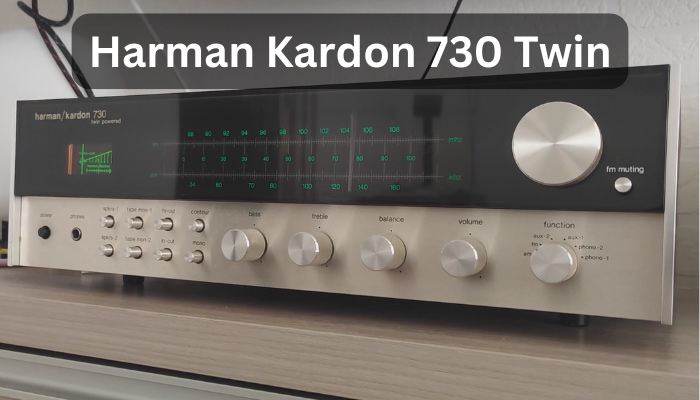
This one was produced between 1976 and 1979. While the 730 Twin can’t compete with other vintage receivers in terms of aesthetics, it really is something when it comes to performance. The receiver stands out with its dual mono construction, which is a feature rarely seen in receivers that come from its era and class. It can deliver 40 watts per channel, but it punches well above its weight, rivaling higher-powered units.
Key Features
| Feature | Details |
|---|---|
| Power Output | 40 watts per channel into 8 ohms, with dual mono construction for excellent channel separation |
| Phono Inputs | Two Phono Inputs, great for vinyl lovers with multiple turntables |
| Auxiliary Inputs | Two Auxiliary Inputs for connecting various devices like CD players or streaming adapters |
| Tape Loops | Two Tape Loops, offering flexibility for recording and playback with tape decks |
| Pre-Out/Main-In Jacks | Yes, enables use as a separate preamp or power amp, providing upgrade paths |
| Speaker Terminals | Supports two sets of speakers (A and B) |
| Build Quality | Solid internal components, emphasis on high-quality circuitry and dual power supplies for each channel |
| Aesthetics | Minimalist design with subtle lighting for the tuner dial and indicators |
| Performance Features | Ultra-wideband frequency response, bass and treble tone controls, high signal-to-noise ratio for clear audio |
Why I Chose Harman Kardon 730 Twin
- Exceptional Sound Quality: You get a wide soundstage and outstanding channel separation thanks to the dual mono design.
- Balanced Sound Signature: The sound is well balanced and transparent, suitable for various music genres.
- Versatile Connectivity: Multiple inputs and outputs bring many connectivity options.
- Unique Engineering: You can’t find dual power supplies in every receiver at this class; this showcases Harman Kardon’s commitment to audio excellence.
- Value for Money: This receiver’s performance is without a doubt better than what its actual power reflects, making it a worthy bargain under $1000.
Drawbacks of this Model
- Fragile Faceplate: The faceplate is thin aluminum, which looks to be prone to dents and scratches.
- Limited Aesthetics: While aesthetics are completely related to the user’s taste, the overall look is simpler than the other vintage receivers introduced in this article and lacks that flashy appearance you want.
4. Sansui 7070
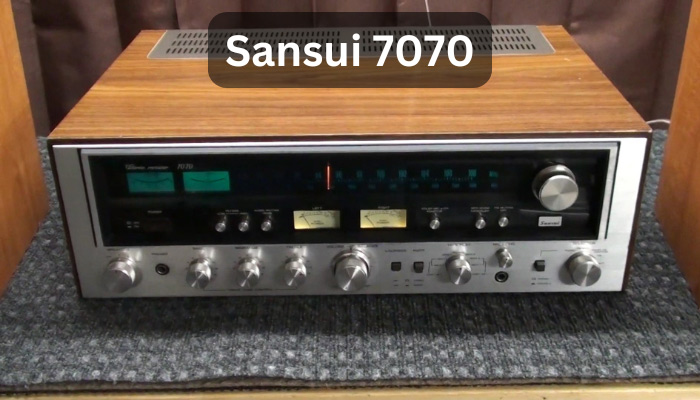
Number 4 in my best vintage receiver list is the Sansui 7070, produced between 1975 and 1977. This one can grab your attention at first sight; the brushed aluminum faceplate, sturdy knobs, and the enchanting aqua blue backlit dial give the receiver a classic look.
With the Sansui 7070, you don’t just get vintage charm. This receiver can deliver 60 watts per channel, which means it can seamlessly handle most audio setups. Its warm sound signature and classic style make it a beloved piece among audiophiles and collectors alike.
Key Features
| Feature | Details |
|---|---|
| Power Output | 60 watts per channel into 8 ohms |
| Phono Inputs | Two Phono Inputs, ideal for vinyl enthusiasts with multiple turntables |
| Auxiliary Input | One Auxiliary Input for connecting additional audio sources like CD players or streaming devices |
| Tape Loops | Tape loops for recording and playback with cassette decks or reel-to-reel tape machines |
| Speaker Terminals | Supports two sets of speakers (A and B) |
| Build Quality | Solid construction with quality components for long-lasting performance |
| Aesthetics | Vintage design with a classic ’70s look and aqua blue backlit tuner dial, brushed aluminum faceplate |
| Performance Features | Warm sound signature with naturally rich bass and smooth mids, tone controls for bass and treble adjustments, FM muting and mono switches enhance tuner functionality |
Why I Chose the Sansui 7070
- Warm Sound Signature: Delivers a warm sound; I’m sure fans of jazz, blues, and classic rock will love this receiver.
- Classic Aesthetics: Truly beautiful, with a mesmerizing design—you can experience love at first sight with it.
- Solid Performance: The 60 watts per channel power output makes this receiver suitable for most setups.
- Versatile Connectivity: Connectivity options are more than enough, perfect for connecting many audio sources.
- Value for Money: Just like its competitors, this model too provides great value for money in the under $1000 price class.
Drawbacks of this Model
Vinyl-Wrapped Cabinet: The cabinet is not wrapped in real wood veneer; it’s actually vinyl-wrapped, which may show wear over time.
No Pre-Out/Main-In Jacks: This receiver doesn’t come with pre-out/main-in jacks, which makes it unable to separate the preamp and power amp sections, limiting upgrade flexibility.
5. Marantz 2240B
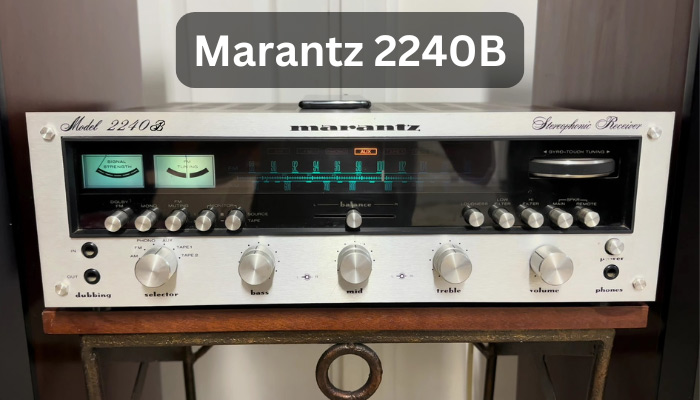
Produced around 1977–1978, the Marantz 2240B delivers 40 watts per channel output. Despite its modest power rating, it is very capable of delivering a warm and rich sound signature that brings music to life. The 2240B comes with an iconic design; it’s got the distinctive Marantz blue backlighting and robust build.
Does Marantz Still Exist?
Yes, Marantz is still a renowned brand when it comes to audio equipment. They combine their classic sound philosophy with modern tech to offer great products. When it comes to receivers, they have perfect AV receivers that can compete with other big names like Denon and Onkyo. For more information, read my Denon vs Marantz guide.
Key Features
| Feature | Details |
|---|---|
| Power Output | 40 watts per channel into 8 ohms |
| Phono Input | One Phono Input, ideal for connecting a turntable |
| Auxiliary Input | One Auxiliary Input for additional audio sources like CD players or streaming devices |
| Tape Loop | One Tape Loop for recording and playback with a cassette deck or reel-to-reel |
| Pre-Out/Main-In Jacks | Yes, offers flexibility to use as a separate preamp or power amp |
| Speaker Terminals | Supports two sets of speakers (A and B) |
| Build Quality | Solid metal chassis for durability and reduced interference, high-quality components reflect Marantz’s excellence |
| Aesthetics | Iconic Marantz design with signature blue backlighting and sleek silver faceplate, classic knobs and switches |
| Performance Features | Warm sound signature delivering rich, full-bodied audio, tone controls for bass, midrange, and treble adjustments, loudness switch enhances low and high frequencies at lower volumes |
Why I Chose the Marantz 2240B
- Exceptional Aesthetics: With the iconic blue glow and classic design, this device can be an appealing part of any setup.
- Warm Sound Signature: When it comes to sound signature, the 2240B proves that it has inherited Marantz’s classic warmth, enriching the listening experience.
- Solid Build Quality: The metal chassis feels robust and promises longevity.
- User-Friendly Interface: The controls are intuitive, and the layout is easy to use.
Drawbacks of this Model
- Modest Power Output: 40 watts per channel may not be enough for power-hungry or less efficient speakers.
- Limited Inputs: Unlike the other models reviewed up to now, this receiver has only one phono and one auxiliary input, making connectivity options somewhat restricted.
- “Marantz Tax”: This is a Marantz receiver, which means the 2240B, while a good receiver, isn’t as competitive as other models when it comes to value for money.
6. Concept 11.0
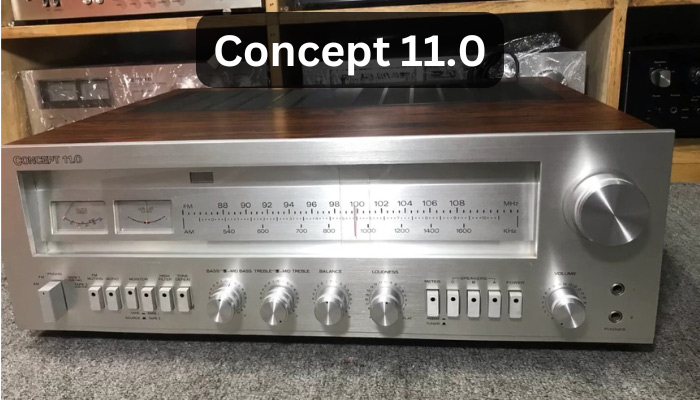
If you’re an audio enthusiast, you probably know the Concept 11.0 as a “sleeper” receiver—one that offers outstanding performance but isn’t widely recognized. I was intrigued to find out about this receiver’s reputation when I first heard it, and it truly lives up to it. This device, produced between 1977 and 1982 by Pacific Stereo, can deliver a substantial 110 watts per channel, making it the most powerful receiver in my “best vintage receivers” list.
The Concept 11.0 not only has awesome sound clarity but also boasts a robust build quality. Its minimalistic design, perfect build quality, and powerful output show us that this receiver was a big competitor for top-tier receivers of its era.
Key Features
| Feature | Details |
|---|---|
| Power Output | 110 watts per channel into 8 ohms, providing ample power for a wide range of speakers |
| Phono Input | One Phono Input, ideal for connecting a turntable |
| Auxiliary Inputs | Two Auxiliary Inputs for multiple audio sources like CD players or streaming devices |
| Tape Loops | Tape loops for recording and playback with cassette decks or reel-to-reel machines |
| Pre-Out/Main-In Jacks | Yes, offers flexibility to use as a separate preamp or power amp |
| Speaker Terminals | Supports three sets of speakers (A, B, and C) |
| Build Quality | Solid construction with heavy-duty chassis and high-quality components, robust power supply for stable performance |
| Aesthetics | Clean design with a straightforward front panel and large illuminated power meters for functional and visual appeal |
| Performance Features | 4-ohm load capability for driving low-impedance speakers efficiently, bass and treble tone controls, loudness switch for enhancing audio presence at lower volumes |
Why I Chose the Concept 11.0
- High Power Output: The amazing 110 watts per channel output can provide excellent headroom and make the receiver suitable for both efficient and demanding speakers.
- Exceptional Build Quality: Components are built with quality in mind, ensuring amazing longevity.
- Unique Appeal: The receiver is not very commonly used but is highly respected among vintage audio circles. So, if you’re somebody who likes to be different, having a Concept 11.0 can definitely give you that feeling.
- Versatile Connectivity: The receiver is equipped with many inputs and has the ability to connect three sets of speakers.
- Value for Money: This model is absolutely one of the best in terms of value for money. While priced below $1000, it can compete with the high-end receivers of its own time.
Drawbacks of this Model
- Limited Brand Recognition: While the Concept 11.0 is well appreciated among audio enthusiasts, non-audiophiles are usually not familiar with this brand. Therefore, the resale value is probably less than brands like Pioneer or Marantz.
- Simplistic Aesthetics: While some people may find the minimalistic design appealing, those who prefer the more elaborate looks of other vintage receivers may find this device’s aesthetics somewhat simplistic.
Why Vintage Receivers Are Worth Considering
If you’re an audio enthusiast like me, from time to time you feel like you miss that good old, authentic sound. You can’t find that rich, nostalgic sound you want in today’s modern, sleek audio equipment. This is what makes vintage stereo receivers special. Let’s dig in to find more reasons why these receivers are still appealing.
Unparalleled Build Quality
Vintage receivers were built with solid wood and metal casings—they’re literally made like tanks. It’s like comparing a muscle car to a modern compact. The build quality is not only satisfying but also promises exceptional longevity and durability.
Rich Sound Signature
The sound coming from vintage receivers is like a cozy blanket on a chilly evening. You can understand me if you’ve ever listened to a vinyl record on one of these devices. The sound is warm and full-bodied; it’s not just about nostalgia. The audio character is special—something you can’t find in today’s world, where every modern AV receiver and other audio devices are digitally dominated. They just don’t have the signature of the analog circuitry and components used in these old stereo receivers.
Aesthetics and Design
Every time I glance at my Yamaha CR-1020, it brings a smile to my face. Vintage receivers come with brushed aluminum plates, tactile knobs, and softly glowing tuner dials; this makes them like a feast for your eyes. Anybody who understands what a classic look from the past means falls in love with these beautiful stereo receivers.
Functionality and Versatility
As I mentioned earlier, vintage receivers aren’t just about nostalgia; they were designed to be the central hub of a home audio system. You can’t deny the fact that these receivers are indeed very functional; you can spin vinyl with them, play cassettes on them, or hook up a digital source. Having multiple phono inputs, tape loops, and pre-out/main-in jacks makes them versatile devices.
Vintage receivers exude a sumptuous, enveloping warmth that modern digital devices can’t rival, their analog circuitry imparting a rare, evocative richness.
Conclusion
Finding the best vintage receiver under $1000 is a journey that involves many hours of research, as there are many legacy, high-quality brands and models out there. In this guide, I tried to streamline the process for you by introducing the best vintage stereo receivers I’ve ever tested and tried. I think these models from Pioneer, Marantz, Sansui, Harman Kardon, Yamaha, and Concept (Pacific Stereo) are very capable of satisfying your taste and needs.
FAQs
Who Made the Best Vintage Receivers?
In my experience, brands like Pioneer, Marantz, Sansui, Yamaha, and Harman Kardon crafted some of the best receivers between 1975 and 1982. I’ve reviewed some of their top models in this article.
Do Old Receivers Sound Better?
The power of old, vintage receivers lies in their analog circuitry, making them able to produce a warm, natural, and rich sound that can’t be found in today’s modern equipment. However, the fact that everybody has their own taste plays a critical role in deciding whether the vintage receivers sound “better” for them or not.
What Were Popular Stereo Brands from the 70s?
These are the most commonly known brands from that era that produced great stereo receivers:
- Pioneer
- Marantz
- Sansui
- Yamaha
- Harman Kardon
- Kenwood
- Technics
Who Buys Old Hi-Fi Systems?
The natural sound and classic character of vintage gear can attract many people, including audio lovers, collectors, or even newcomers to the world of audio equipment. These old systems add a taste of nostalgia to your setup.
What Is the Most Powerful Pioneer Receiver Ever Made?
The Pioneer SX-1980 is the most powerful Pioneer receiver ever made. This model was produced between 1978 and 1980 and can deliver a massive 270 watts per channel into 8 ohms—it’s literally a beast.




